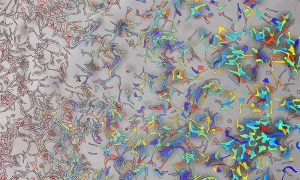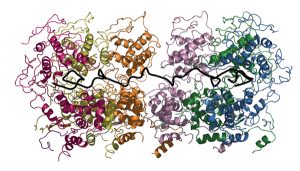
Predicting cancer risk on the basis of national health data
Science & Technology Large-scale study uses data from Danish health registries to predict individual risks of developing cancer
2024
research-highlightsscience-technology

Science & Technology Large-scale study uses data from Danish health registries to predict individual risks of developing cancer
2024
research-highlightsscience-technology

Science & Technology Enabling researchers worldwide to share and analyse pathogen data generated across the world
2023
sciencescience-technologytechnology-and-innovation
Researchers have genetically profiled nearly 200,000 cells from lungs, mapping their precise locations in tissue to discover an unexpected new immune niche in our airways.
2022
research-highlights

Lab MattersScience & Technology A new grant will provide a way for fundamental metabolomic research to realise its commercial potential and promise in aiding drug development and precision medicine.
2022
lab-mattersscience-technology

Connections The upcoming 22nd EMBL Science & Society Conference will explore the One Health approach, which advocates for greater cross-sectoral collaboration and communication across the human-animal-environment interface.
2021
connectionsevents

Science & Technology If researchers can identify specifically when good cells go bad, they can potentially understand disease better.
2021
sciencescience-technology

Science & Technology A page from a biologist’s colouring book? EMBL’s new interior wall design? Not quite – a bunch of liver cells, grown in the lab so that scientists can learn about fatty liver disease, or steatosis.
2021
picture-of-the-weekscience-technology
Science & Technology Scientists in the Stegle group and colleagues have studied induced pluripotent stem cells from around 1,000 donors to identify correlations between individual genetic variants and altered gene expression. They linked more than 4,000 of the genetic variants responsible for altered expression…
2021
sciencescience-technology

Science & Technology Researchers in EMBL’s Zaugg group have studied the causes of pulmonary arterial hypertension (PAH), a rare disease that causes high blood pressure in the arteries of the lungs. The study, carried out in collaboration with Stanford University School of Medicine, compared lung cells of patients…
2020
sciencescience-technology
Science & Technology Studies screening the genome of hundreds of thousands of individuals (known as Genome-wide association studies or GWAS) have linked more than 100 regions in the genome to the risk of developing cardiovascular disease. Researchers from the European Molecular Biology Laboratory (EMBL) and the…
2013
sciencescience-technology
Science & Technology Genetic recombination, the process by which sexually reproducing organisms shuffle their genetic material when producing germ cells, leads to offspring with a new genetic make-up and influences the course of evolution. In the current issue of Nature, researchers at the European Molecular…
2008
sciencescience-technology
Science & Technology Leukaemia – cancer of blood or bone marrow – is caused by mutations that allow defective blood cells to accumulate and displace healthy blood. To devise effective therapies it is crucial to know which mutations cause leukaemia and which cell type gives rise to leukaemic cells. Researchers from…
2008
sciencescience-technology
Science & Technology Much less widely known than the dangerous consequences of iron deficiencies is the fact that too much iron can also cause problems. The exact origin of the genetic iron overload disorder hereditary hemochromatosis [HH] has remained elusive. In a joint effort, researchers from the European Molecular…
2008
sciencescience-technology
Lab Matters Today the European Molecular Biology Laboratory (EMBL), the University of Helsinki, Finland, the University of Oslo, Norway, and Umeå University, Sweden, officially launch their new Nordic EMBL Partnership for Molecular Medicine. The agreement will encourage scientific exchange and collaborations…
2007
lab-matters
Science & Technology Many neuronal disorders, including epilepsy, schizophrenia and lissencephaly ─ a form of mental retardation ─ result from abnormal migration of nerve cells during the development of the brain. Researchers from the Mouse Biology Unit of the European Molecular Biology Laboratory (EMBL) in Italy,…
2007
sciencescience-technology
Science & Technology Researchers from the European Molecular Biology Laboratory (EMBL) and the University of Michigan have discovered a gene that protects us against a serious kidney disease. In the current online issue of Nature Genetics they report that mutations in the gene cause nephronopthisis (NPHP) in humans and…
2007
sciencescience-technology
Science & Technology Why does the same diet make some of us gain more weight than others? The answer could be a molecule called Bsx, as scientists from the European Molecular Biology Laboratory (EMBL), the German Institute for Nutrition (DIFE), Potsdam, and the University of Cincinnati report in the current issue of…
2007
sciencescience-technology
Science & Technology Inflammatory bowel diseases, such as Crohn’s disease and Ulcerative Colitis, severely impair the lives of more than four million people worldwide. The development of effective therapies against these diseases requires an understanding of their underlying molecular mechanisms. Researchers from…
2007
sciencescience-technology
Science & Technology Depression, coordination and speech problems, muscle weakness and disability are just a few of the symptoms of Multiple Sclerosis (MS). Researchers from the Mouse Biology Unit of the European Molecular Biology Laboratory (EMBL) in Italy and the Department of Neuropathology at the Faculty of…
2006
sciencescience-technology

Science & Technology Ebola, measles and rabies are serious threats to public health in developing countries. Despite different symptoms all of the diseases are caused by the same class of viruses that unlike most other living beings carry their genetic information on a single RNA molecule instead of a double strand of…
2006
sciencescience-technology
Science & Technology Tuberculosis remains one of the deadliest threats to public health. Every year two million people die of the disease, which is caused by the microorganism Mycobacterium tuberculosis. Roughly one third of the world’s population is infected and more and more bacterial strains have developed…
2006
sciencescience-technology
ConnectionsLab Matters Today three research organisations announce the merging of their expertise to fight cardiovascular diseases, which are among the most common health problems and causes of death in the world. The Magdi Yacoub Institute (MYI) at the UK’s Harefield Heart Science Centre, Imperial College London,…
2006
connectionslab-matters
Science & Technology A detailed structural picture of a molecule that plays a key role in activating the Epstein Barr Virus in human cells has now been obtained by researchers at the European Molecular Biology Laboratory (EMBL) and the Institut de Virologie Moléculaire et Structurale (IVMS), associated with the…
2006
sciencescience-technology
Science & Technology Researchers at the International Centre for Genetic Engineering and Biotechnology (ICGEB) in India and a unit of the European Molecular Biology Laboratory (EMBL) in France have made a key discovery about a molecule that helps the malaria parasite infect human cells. India is one of the countries…
2005
sciencescience-technology
Science & Technology Most of what happens in cells is the work of machines that contain dozens of molecules, chiefly proteins. With the completion of human and other genomes, researchers now have a nearly complete ‘parts list’ of such machines; what’s lacking is the manual telling where all the pieces…
2005
sciencescience-technology
Lab MattersScience & Technology The Commission of the European Union has awarded EUR 9 million over five years for a new Network of Excellence that will make computational systems biology accessible to bench scientists throughout Europe and beyond. ENFIN, which stands for ‘Experimental Network for Functional…
2005
lab-mattersscience-technology
Science & Technology Mutations in genes are the basis of evolution, so we owe our existence to them. Most mutations are harmful, however, because they cause cells to build defective proteins. So cells have evolved quality control mechanisms that recognize and counteract genetic mistakes. Now scientists of the Molecular…
2005
sciencescience-technology
No matching posts found
Looking for past print editions of EMBLetc.? Browse our archive, going back 20 years.
EMBLetc. archive